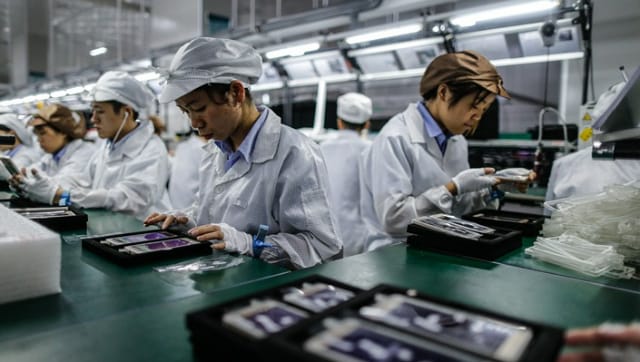Mehul Reuben DasDec 27, 2022 13:07:54 IST
According to the most recent official data released by the Chinese government, smartphone sales in the country fell 22 per cent in the first 10 months of the year as a result of waning domestic demand and unrest in the country’s manufacturing supply chain. China also happens to be the world’s largest smartphone market. In October 2022 alone, the shipment of smartphones for domestic sale dropped by 27.2 per cent, compared to October 2021.

The slowdown of the Chinese smartphone industry has led to several manufacturers announcing massive layoffs. This, along with the supply chain disruptions and falling demand is prompting fears that the economic situation in China will only worsen. Image Credit: AFP
According to a report released on Monday by the China Academy of Information and Communications Technology (CAICT), a scientific research centre under the Ministry of Industry and Information Technology, there were 214.5 million smartphones shipped to the nation overall from January to October of this year, down from 275.3 million units during the same period last year.
The slow demand for smartphones in China is evident in the most recent CAICT numbers, as more customers are putting off new purchases due to the weakening home economy and stringent mobility limitations imposed by Beijing’s zero-COVID-19 policy. Although it is expected that the industry will bounce back and that demand will increase, the extent of the increase in demand is hard to determine.
Even though the Chinese government has relaxed its zero-COVID-19 policy, China is set to be ambushed by one of the worst COVID-19 outbreaks as reports of hospitals and China’s medical system coming to its knees, are surfacing day after day.
While consumer confidence and the economy in China would take time to recover,
The decrease in the country’s smartphone market is expected to level out and rise back up to normal starting next year. A complete comeback is projected to occur in 2024, according to a report released earlier this month by tech research firm IDC.
Slowing consumer demand has already prompted major smartphone manufacturers to curtail their spending. Xiaomi, for example, conducted a new round of layoffs, which saw them terminate nearly 10 per cent of its workforce. Apart from the recent firing, Xiaomi had cut more than 900 jobs earlier this year.
According to figures issued by the National Bureau of Statistics, China’s retail sales plunged in November, down 5.9 per cent from a year earlier. This number fell short of forecasts, dropping from -0.5 per cent in October to the lowest reading since plunging to -6.7 per cent in May and -11.1 per cent in April.
Even Apple has been scrambling to fix problems in its manufacturing supply chain on the mainland. Production of its popular iPhone 14 Pro models at Foxconn Technology Group’s plant in Zhengzhou, the capital of central Henan province, has been hit by severe disruptions including worker protests that turned violent and the exodus of tens of thousands of employees because of a COVID-19 outbreak at the facility.
Apple’s production troubles in China caused the company to supply 20 per cent fewer handsets during the holiday season than what was initially anticipated.
{n.callMethod? n.callMethod.apply(n,arguments):n.queue.push(arguments)}
; if(!f._fbq)f._fbq=n;n.push=n;n.loaded=!0;n.version='2.0'; n.queue=[];t=b.createElement(e);t.async=!0; t.src=v;s=b.getElementsByTagName(e)[0]; s.parentNode.insertBefore(t,s)}(window,document,'script', 'https://connect.facebook.net/en_US/fbevents.js'); fbq('init', '259288058299626'); fbq('track', 'PageView');
For all the latest Technology News Click Here
For the latest news and updates, follow us on Google News.
